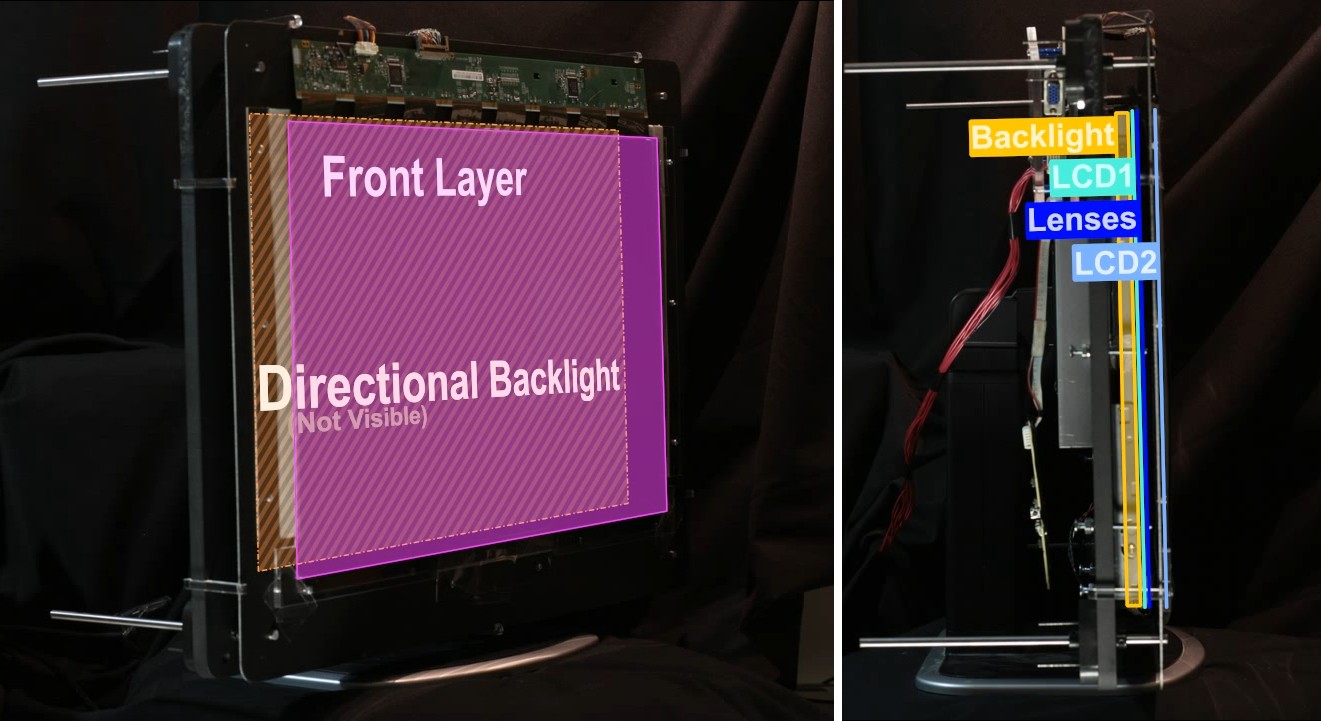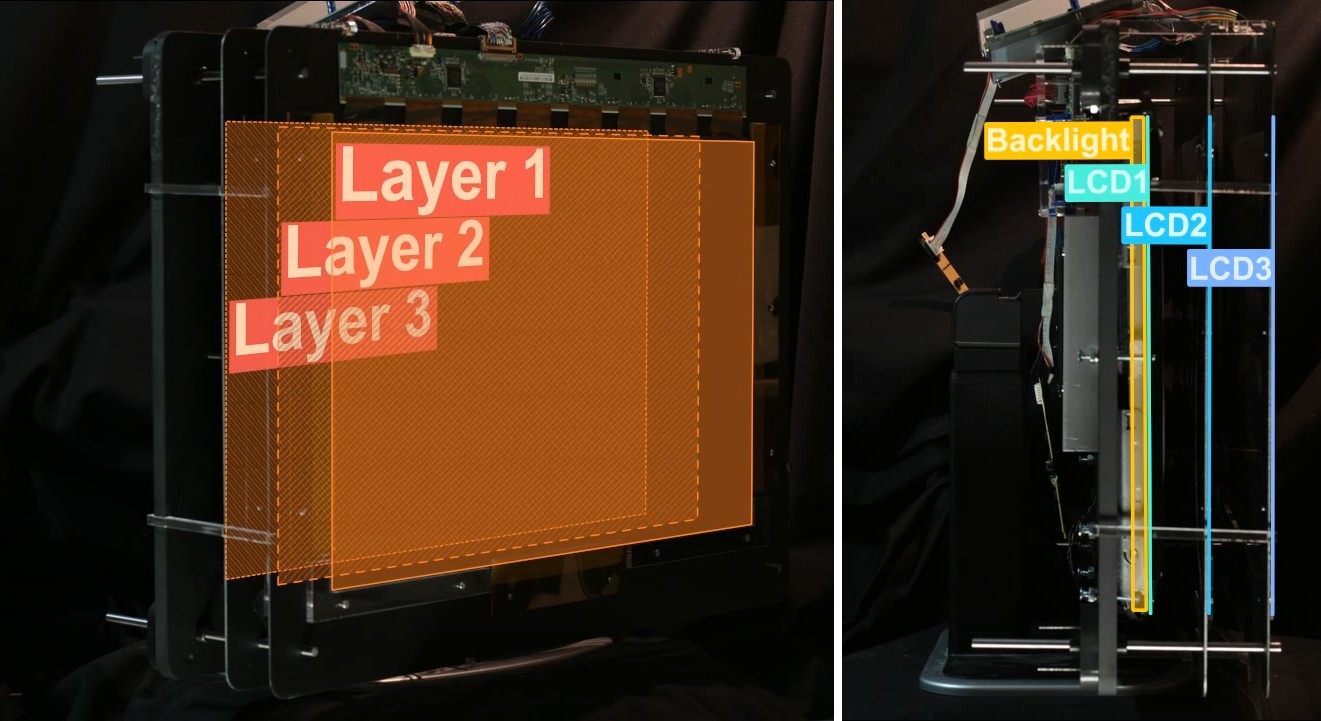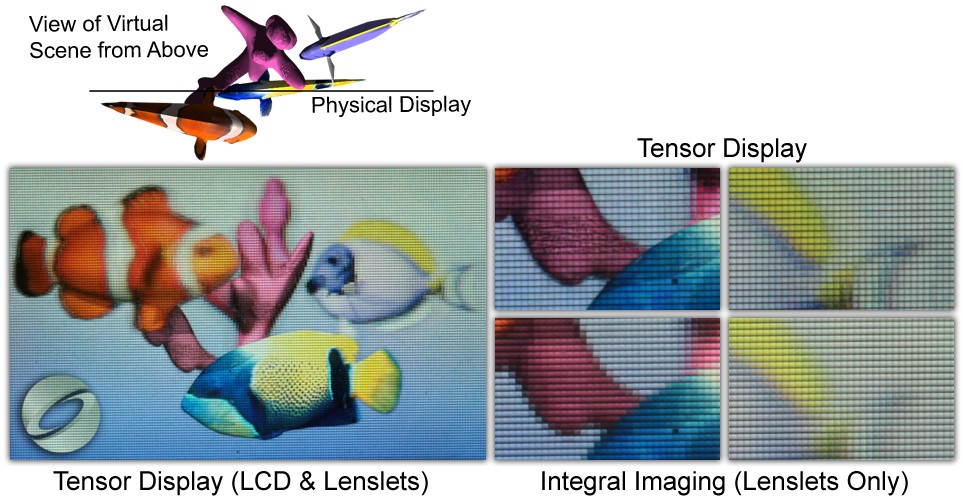Tensor Displays: Compressive Light Field Synthesis using Multilayer Displays with Directional Backlighting
| Gordon Wetzstein | Douglas Lanman | Matthew Hirsch | Ramesh Raskar |
| MIT Media Lab – Camera Culture Group | |||
SIGGRAPH 2012. ACM Transactions on Graphics 31(4).
Abstract
We introduce tensor displays: a family of compressive light field displays comprising all architectures employing a stack of time-multiplexed, light-attenuating layers illuminated by uniform or directional backlighting (i.e., any low-resolution light field emitter). We show that the light field emitted by an N-layer, M-frame tensor display can be represented by an Nth-order, rank-M tensor. Using this representation we introduce a unified optimization framework, based on nonnegative tensor factorization (NTF), encompassing all tensor display architectures. This framework is the first to allow joint multilayer, multiframe light field decompositions, significantly reducing artifacts observed with prior multilayer-only and multiframe-only decompositions; it is also the first optimization method for designs combining multiple layers with directional backlighting. We verify the benefits and limitations of tensor displays by constructing a reconfigurable prototype using modified LCD panels and a custom integral imaging backlight. Our efficient, GPU-based NTF implementation enables interactive applications. Through simulations and experiments we show that tensor displays reveal practical architectures with greater depths of field, wider fields of view, and thinner form factors, compared to prior automultiscopic displays.
In the News
 Wired – MIT’s Camera Culture group is working on a goggle-free 3D TV experience, November 2012
Wired – MIT’s Camera Culture group is working on a goggle-free 3D TV experience, November 2012
Files
Citation
G. Wetzstein, D. Lanman, M. Hirsch, R. Raskar. Tensor Displays: Compressive Light Field Synthesis using Multilayer Displays with Directional Backlighting. Proc. of SIGGRAPH 2012 (ACM Transactions on Graphics 31, 4), 2012.
BibTeX
@article{Wetzstein:2012:TensorDisplays,
author = {G. Wetzstein and D. Lanman and M. Hirsch and R. Raskar},
title = {{Tensor Displays: Compressive Light Field Synthesis using Multilayer Displays with Directional Backlighting}},
journal = {ACM Trans. Graph. (Proc. SIGGRAPH)},
volume = {31},
number = {4},
year = {2012},
publisher = {ACM},
pages = {1--11},
address = {New York, NY, USA}
}
Additional Information
| Figure 2: Two prototype tensor displays. (Left) A directional backlight, consisting of two crossed lenticular sheets mounted on an LCD, with an additional see-through liquid crystal panel mounted in front of it. This display provides a wide field of view (approx. 48°) within a very thin form factor (as seen in the center left view). (Right) A prototype configured as a three-layer display; three see-through LCD panels are mounted in front of a uniform backlight. The panels are mounted on custom aluminum frames with driver electronics mounted on the frames.Image credit: MIT Media Lab, Camera Culture Group |
|
|
| Figure 3: Directional backlight prototype (see Fig. 2, left) compared to conventional 3D display. A thin, glasses-free 3D display creates the illusion of a virtual scene floating in front and behind the physical device (left). The directional backlight, consisting of a lenslet array mounted on an LCD, provides low-resolution 3D images with an additional see-through LCD mounted in front of the lenslets. With this tensor display prototype, we achieve a much higher resolution than with the lenslets only (see top vs. bottom closeups); the latter is commonly known as integral imaging and basically reduces the image resolution by turning each lenslet into a pixel (bottom center and right), whereas tensor displays achieve the full panel resolution for objects on the display plane (center column) and those extruding from the physical enclosure (right column).Image credit: MIT Media Lab, Camera Culture Group |
| Figure 4: Two views of the directional backlight prototype (see Fig. 2, left). Tensor displays are compressive displays, which means that many target views showing a 3D scene from slightly different positions (a light field) are compressed into the pixel values of a display that has a smaller bandwidth than the target light field would normally require. A one-to-one mapping between light field rays and display pixels does not exist; instead, the computational processing (non-negative light field tensor decomposition) automatically computes time-varying patterns for each display element (right column) that are optically overlayed and perceptually averaged by the observer. The viewer does not perceive the high-frequency patterns, but observes binocular disparity and smooth motion parallax for a wide range of viewpoints as he moves around the display (left and center). While the displayed patterns (right) look like noise on first sight, they actually represent the optimal patterns for displaying the entropy in a compressible target light field.Image credit: MIT Media Lab, Camera Culture Group |
|
|
| Figure 5: Just as cameras with large apertures, all glasses-free 3D displays have a limited depth of field. That means, virtual objects that extrude more from the physical display enclosure are blurrier than those close to the device. This figure shows a comparison of upper bounds on depth of field for parallax barriers and integral imaging (red), two-layer (blue) and three-layer (green) displays with uniform backlighting, and single-layer (yellow) and two-layer (orange) displays with directional backlighting. The dashed black line denotes the spatial cutoff frequency for each layer. As seen in these plots, all tensor displays achieve a much higher resolution compared to conventional displays (dashed red line). Multilayer tensor displays provide a very large depth of field, while directional backlighting provides a very thin display form factor.Image credit: MIT Media Lab, Camera Culture Group |
Contact
Gordon Wetzstein, PhD
MIT Media Lab
gordonw (at) media.mit.edu






